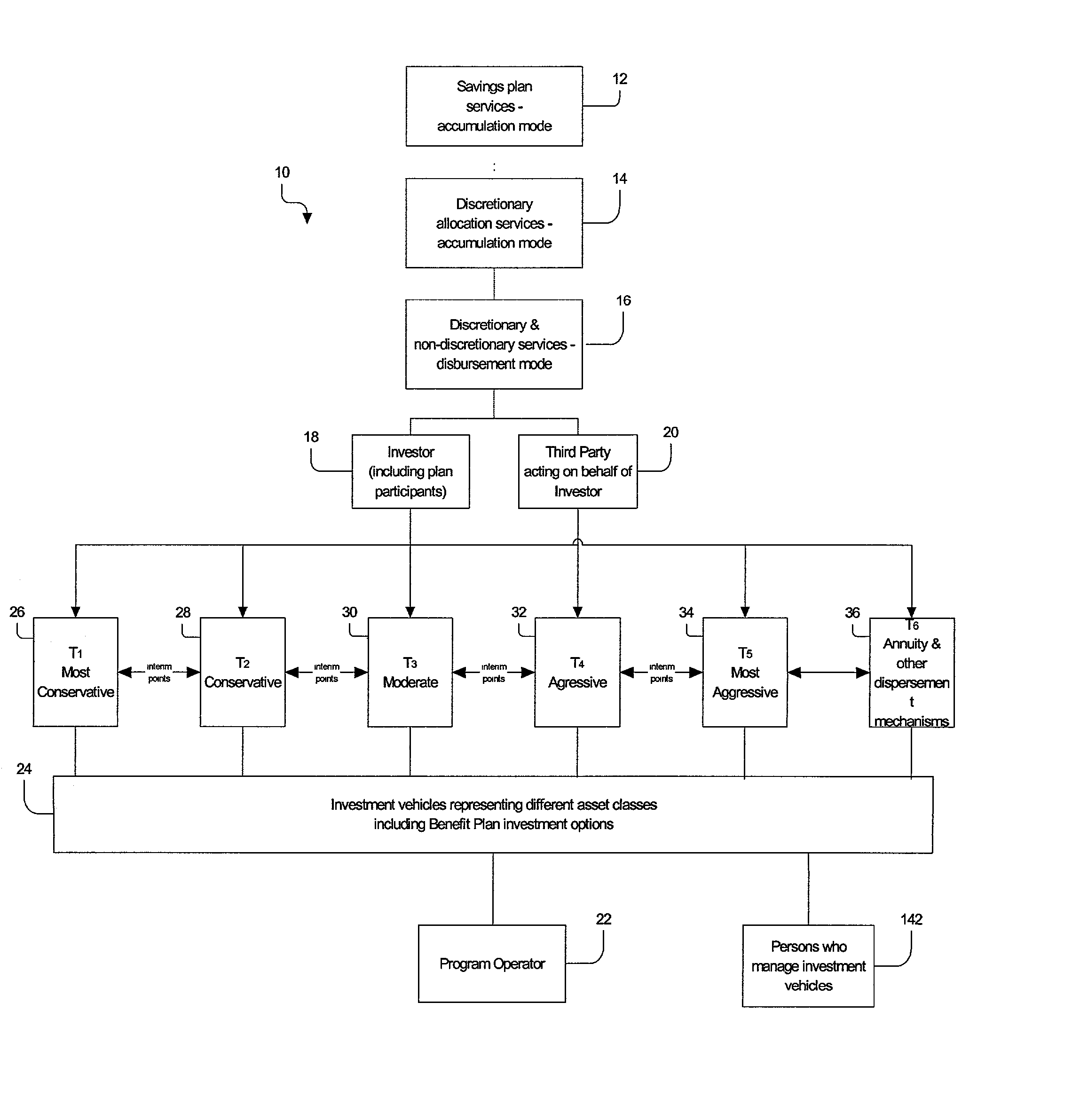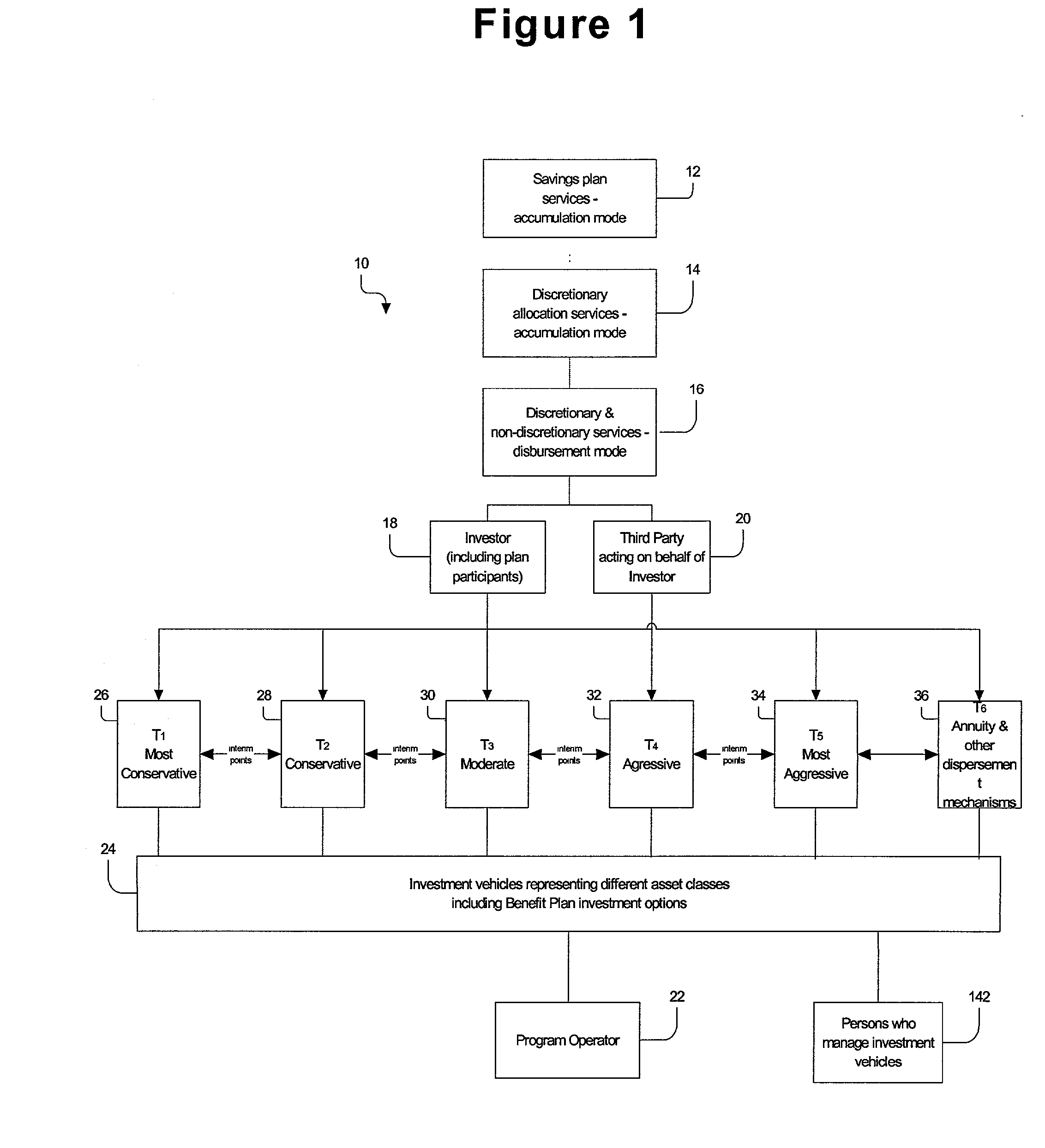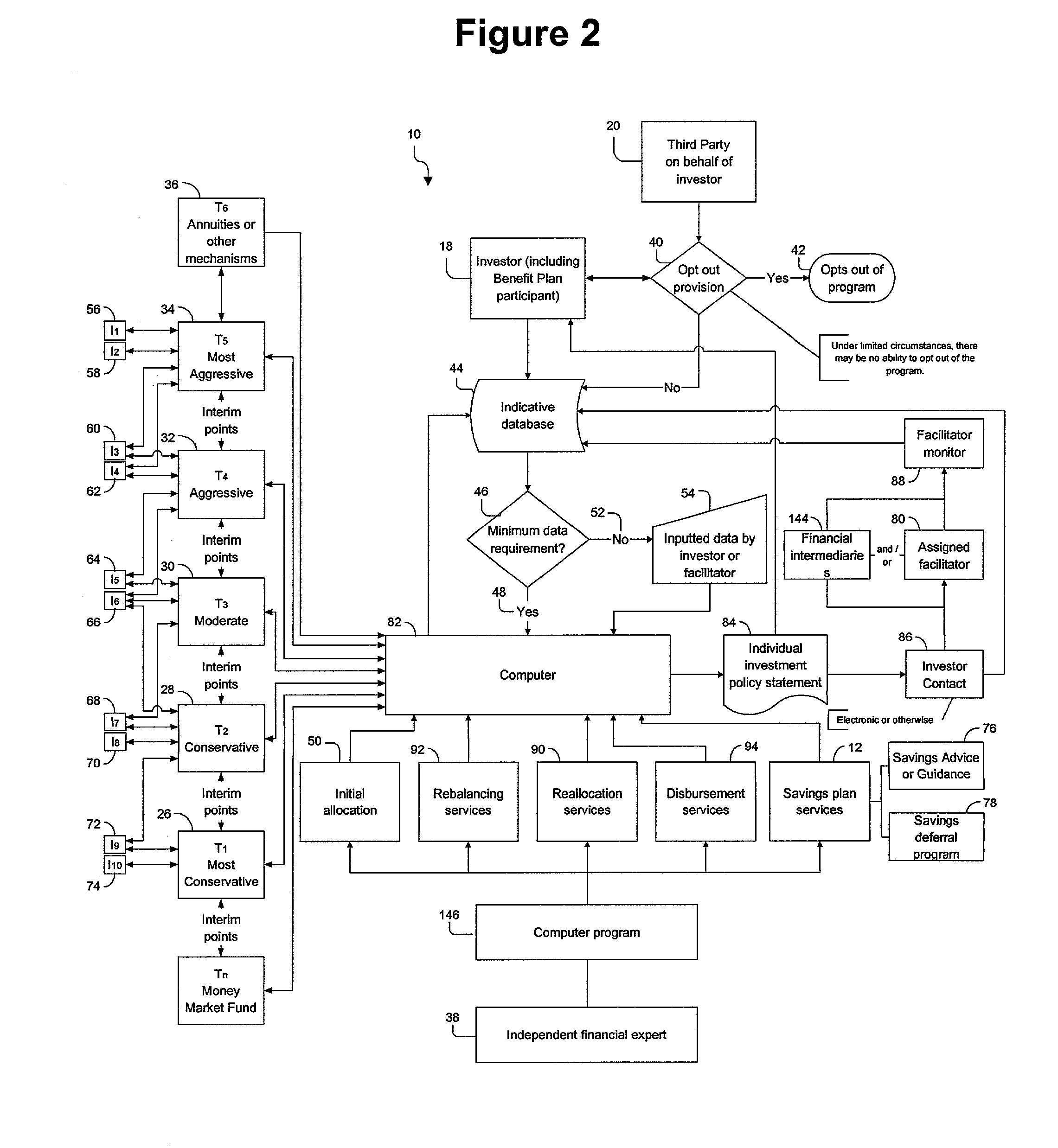Unfortunately, the above-described methods are yet to achieve the desired results.
Despite investments in the above described methods, most individuals, including many participants in self-directed, individual account plans, do not even participate, and when most individuals do participate, most individuals do not appropriately save and invest, including a failure to participate in 401(k) plans, nor do they save sufficient amounts, as reported in O. S. Mitchell, J. F. Moore, 1998, "Can Americans Afford to Retire?
The findings from these studies strongly suggest that current 401(k) Employee Benefit Plans are not optimally designed to meet the needs of the "financially uninvolved" segment of Employee Benefit Plan eligible employees.
Specifically, it is presently believed that the problems described above for both the financially involved and the financially uninvolved result from the fact that currently, individuals are either: 1) too involved in the process of selecting investments and frequently do so by choosing investments based on the recent performance of individual investment vehicles; 2) do not save appropriate amounts to meet their goals, including retirement; or 3) more often, they feel they do not have the time, interest, and / or expertise to make appropriate investments or structure appropriate savings plans.
The process described above as used by individuals typically results in inadequate funding levels (low savings rates) and inappropriate investment including suboptimal allocations.
Specifically, it is presently believed that the problems described above for both the financially involved and the financially uninvolved result from the fact that, currently, the process of carrying out the necessary steps to appropriately save, as outlined above, is still too overwhelming for even the financially involved, much less the financially uninvolved.
It is presently believed that one of the possible reasons for the inadequate savings situations, as describe above, is that saving for the future is typically something that is put off until tomorrow, especially by financially uninvolved investors and especially, by individual Benefit Plan participants in the absence of effective investment assistance.
In the case of Employee Benefit Plans lack of participation by eligible employees, it has been and is presently a persistent problem that Benefit Plan sponsors face with the implementation of Benefit Plans.
One of the main reasons given by individual investors for nonparticipation in Benefit Plans for which they are eligible is that the process of optimally making a decision to start any savings plan, including participation in a 401(k) plan is complicated, as viewed by the average potential Benefit Plan participant or eligible participant.
Studies by psychologists have shown that increasing the complexity of a decision-making task leads individuals to defer making a decision or to procrastinate and such appears to be prevalent among the average potential Benefit Plan participants.
It is presently believed that there are at least two sources of complexity in starting any savings program, such as, for example, Benefit Plans, including making the initial decision to "opt in" as a plan participant and then making an optimal 401(k) Benefit Plan investment allocation decision.
First, the shear number of possible investment allocation options to be evaluated by individual investors is enormous.
For the "financially uninvolved" employees, a
second source of complexity is learning how to evaluate the myriad of 401(k) Benefit Plan investment allocation options that are available.
Thus, individual investors may rationally postpone making a decision on savings, including 401(k) Benefit Plan participation, most likely because the cost in time and effort of gathering the information necessary to make an intelligent choose from among the myriad of 401(k) Benefit Plan investment allocation options that are available may exceed the sort-term benefit from making such a decision, as viewed by large numbers of individual investors.
In the situation described above, the "lose" aspect of automatic enrollment being that automatic enrollment has apparently generated a tremendous amount of employee Benefit Plan participant
inertia.
A substantial percentage of 401(k) Benefit Plan participants hired under an automatic enrollment policy exhibit "default behavior"--sticking to both the default contribution level and the default investment allocation, both of which is usually less than optimal with respect to future
impact on the individuals or national budgetary policy.
It is believed that the best explanation for the low participation rate of new hires, in the absence of an automatic enrollment policy, is that the decision to participate in the Benefit Plan is complicated, which leads individual employees to defer making a decision and to procrastinate with respect to making a definite decision.
Utilization of an automatic enrollment policy apparently decreases the perceived complexity of the 401(k) Benefit Plan participation decision by decoupling the participation decision from the savings and investment decision.
The bad news, however, is that roughly sixty percent (60%) of the employees that have been automatically enrolled subsequently did nothing to increase their fairly low three percent (3%) contribution rate or to reallocate their contributions away from the default investment option to a more individually appropriate investment or to recognize the importance of appropriately individual funding for future liabilities, and then determine an appropriate individual funding policy and asset allocation model to best fund individually perceived future liabilities, and only then select investment vehicles based on the ability to implement the individual model allocation--thus recognizing that money management (i.e., security selection) is of secondary importance for passive, long-term investors.
The "financially uninvolved," it is believed, have a much greater tendency to stick with the status quo investment(s) (when one is available) as financial decisions become more difficult.
If the default investment allocation is not optimized, citizens, in general, and Benefit Plan participants in particular, will most likely have less retirement income, pay less tax and, as a result, create additional financial demands and stress on the government because, as a result of less optimum investment allocation during the life of a Benefit Plan participant, the government will collect less revenue and, thus, have less income at the same time government will most likely be experiencing increased demand for services from persons with inadequate retirement income.
In this regard, existing evidence indicates that the negative effect caused by the increased demand for services from persons with inadequate retirement income would tend to be concentrated among persons who are the least advantaged members of United States society, and, as a result, the social strains resulting from such members, who have not fared well in optimizing their investment allocation, could be expected to increase.
Another problem that has surfaced is that Benefit Plan sponsors are increasingly concerned that by the Benefit Plan sponsors increasing the initial contribution rate, employees may be induced to opt-out of 401(k) Benefit Plan participation, and just as there has been and is participation
inertia, there will be non-participant
inertia as well.
Many Benefit Plan sponsors are wary of choosing default fund allocations that includes equities because they are concerned that the Benefit Plan sponsors will be blamed if the investment returns fall or are negative during adverse market periods.
Thus, it appears highly questionable that a prudent expert would ever use a "one size fits all" investment selection approach for all individual Benefit Plan participants (such as investing in a money-market fund), given the clear known existence of the enormous individual differences in funding requirements,
time horizon, risk tolerance, etc., and other factors related to making an optimum asset allocation and investment decision, including Benefit Plan asset allocation.
Again, it is highly questionable that a prudent expert would recommend a conservative Benefit Plan investment allocation such as a money market fund for younger Benefit Plan participants, which when combined with a low Benefit Plan default contribution rate, will likely ultimately result in the realization of an inadequate amount of savings in order to fund future retirement income needs at an appropriate level without placing undue financial burdens on various government organizations and adversely impacting national budgetary considerations.
The problem with specifying a one-size-fits-all Benefit Plan default allocations is that, for individuals, appropriate Benefit Plan contribution levels and asset allocation determinations are based on the employee's unique needs and circumstances, which change over time as employees get closer to retirement and individual employee wealth increases.
Similarly, it may be imprudent to use the Benefit Plan's balanced fund, or similar vehicle as the default Benefit Plan choice for older employees, who may lack the ability to make up losses that may occur during adverse
market conditions.
Another problem that has long been acknowledged relating to optimizing investment portfolios for Benefit Plan participants is that the entities and / or persons most capable of delivering an optimum investment solution typically have financial interests that may be or are inconsistent with that of the individuals who need investment allocation services.
Similar or identical conflicts of interest also occur when determining how to invest at a time when persons are no longer working.
These situations could lead to persons with inconsistent interests intentionally or unintentionally acting to cause amounts to be saved or invested so that these persons with inconsistent interests enjoy a higher income, a situation possibly not in the best interest of the individual Benefit Plan participant whose funds are being invested by the persons providing traditional services for the Benefit Plan.
No person who currently offers "investment advice" or "education" and is
solvent has or could reasonably offer a meaningful guarantee.
"Investment advisors" will not make such a guarantee because they are granted non-discretionary investment management authority, and thus do not exercise control of the allocations on a regular basis.
Research demonstrates that active trading, on the average, materially diminishes investment returns.
First, most workers realize they need to save more, but lack discipline.
Third, people are very sensitive to perceived losses in their welfare.
While we can imagine foregoing some
gain, bearing a loss is much more difficult.
In fact, since the contribution to the saving plan is tax deductible, only part of the increased saving is out-of-pocket, and the actual change in the paycheck is likely to be unnoticeable.
In fact, since the contribution to the savings plan is tax deductible, only part of the increased savings is out-of-pocket, and the actual change in the paycheck is likely to be unnoticeable.
 Login to View More
Login to View More  Login to View More
Login to View More 


